Rapier Spear Construction and Inspection Guide
Author: Master Brian de Moray, KRM
Last Modified: 2024-05-07
Revision: 83594b8
The intent of this guide is to provide a repeatable and reasonable way to inspect spears as well as an example method to construct spears that passes the inspection guide.
Inspection Guide
- Check that the spear meets diameter, length, and taping requirements.
- Check the spear head flexes with hand pressure to 90 degrees and substantially return to it’s original shape within 3 seconds.
- Spear heads with separate socket and blade components should not flex in the socket portion when hand pressure is used at the base of the blade.
Inspection photos
- Checking spear head flex at the tip by adding hand pressure at the tip. In this photo, the head is only pressed slightly to show the type of flex that is expected, a gradual curve across the blade portion of the head. During inspections, the head must be able to flex to a full 90 degrees with hand pressure.
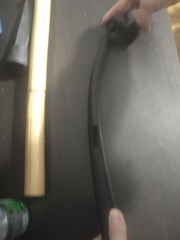
- In this photo, the head is pressed with hand pressure at the base of the blade before the socket with no meaningful bend or flex of the socket. In this example, the rattan was inserted to the maximum depth of the socket.

- In this photo, the head is pressed with hand pressure at the base of the blade before the socket, with a kink that occurs in the socket, causing the entire head to fold over. In this example the rattan was only inserted 4”, rather than the possible 7.5” possible with this particular head. The kink in the socket, rather than gradual bend seen in the pictures showing the blade portion flexing, is the critical failure point.
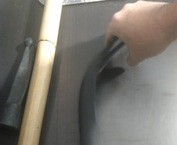
Constructing Spears
Spears are constructed using a rubber head mounted on a rattan haft.
Society policy requires the following as to how the haft is inserted into the head:
- The haft of a spear must be inserted at least 2” into the head.
- The part of the haft inserted into the head may be shaved down to a minimum diameter of 1/2” to fit.
- The haft must inserted such that at least 4” of rubber remains unencumbered with the haft.
- The haft must be “friction fit” into the head, then taped on using reinforced tape. Attach contrasting tape or ribbon at the base of the head to provide visual contrast in case the spear head comes off.
Some spear heads constructed following minimum standards, especially those with separate socket and spike component, may flex in the socket portion of the head which will cause a critical failure of the equipment.
Spears should be constructed such that the maximum, rather than minimum amount of haft is inserted into the head while still leaving at least 4” of rubber unencumbered from the haft.
Construction guide
- Insert a 1/2” dowel into the head such that at least 4” of rubber remains encumbered when the head is pushed from the side.
- Mark the depth the dowel is inserted.
- Use the mark on the dowel to indicate the depth the rattan should be inserted into the head.
- Shave down the rattan such that it fits into the head, taking careful note to not shave the narrower than 1/2” in diameter.
- Hints:
- Draw a 1/2” diameter circle on the end of the rattan to provide a guide.
- Shave down the rattan a small amount at a time, repeatedly checking the minimum diameter and depth the rattan fits into the socket.
- Take care to follow the shape of the socket in the spear head such that the head can be friction fit.
- Hints:
- Once the rattan can be fully inserted into the socket and is friction fit, add reinforced tape to ensure the head stays attached.
- Add band of contrasting tape at the base of the head.
Construction photos
- 1/2” dowel next to head and rattan.
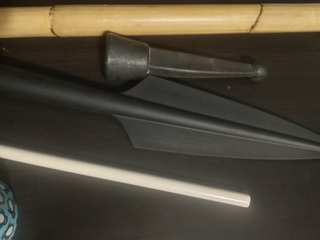
- Inserting 1/2” dowel into the head to mark depth of insertion.
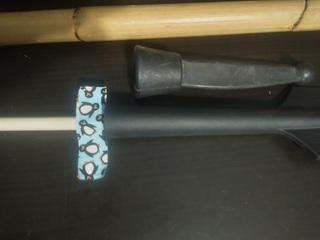
- Marking the depth the dowel was inserted onto the rattan.
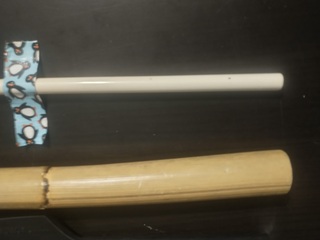
Links
- 3d printable Spear Diameter Gauge: Published by Xandra Rozina Xiberras Galea (Rozi), this is an SDL (3d printing file) that can be used to create a tool intended to check the minimum and maxmimum diameter of a rattan shaft for use in rapier combat.
- SCA Rapier Spears Facebook Group: This group hosts information from the experiment that resulted in the inclusion of rubber-headed spears in rapier.
- Spears in SCA Fencing Facebook Group: This group is intended to foster society-wide discussion for the adoption of spears in rapier.